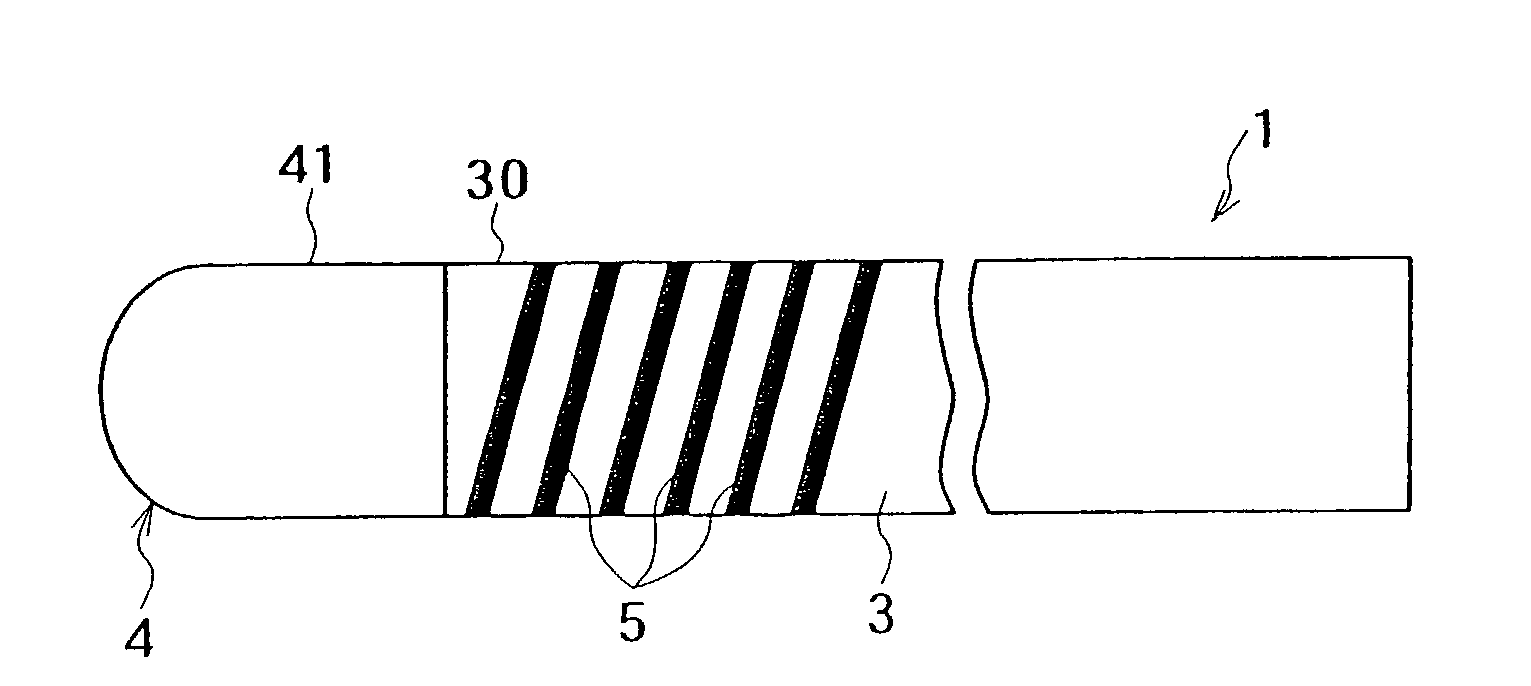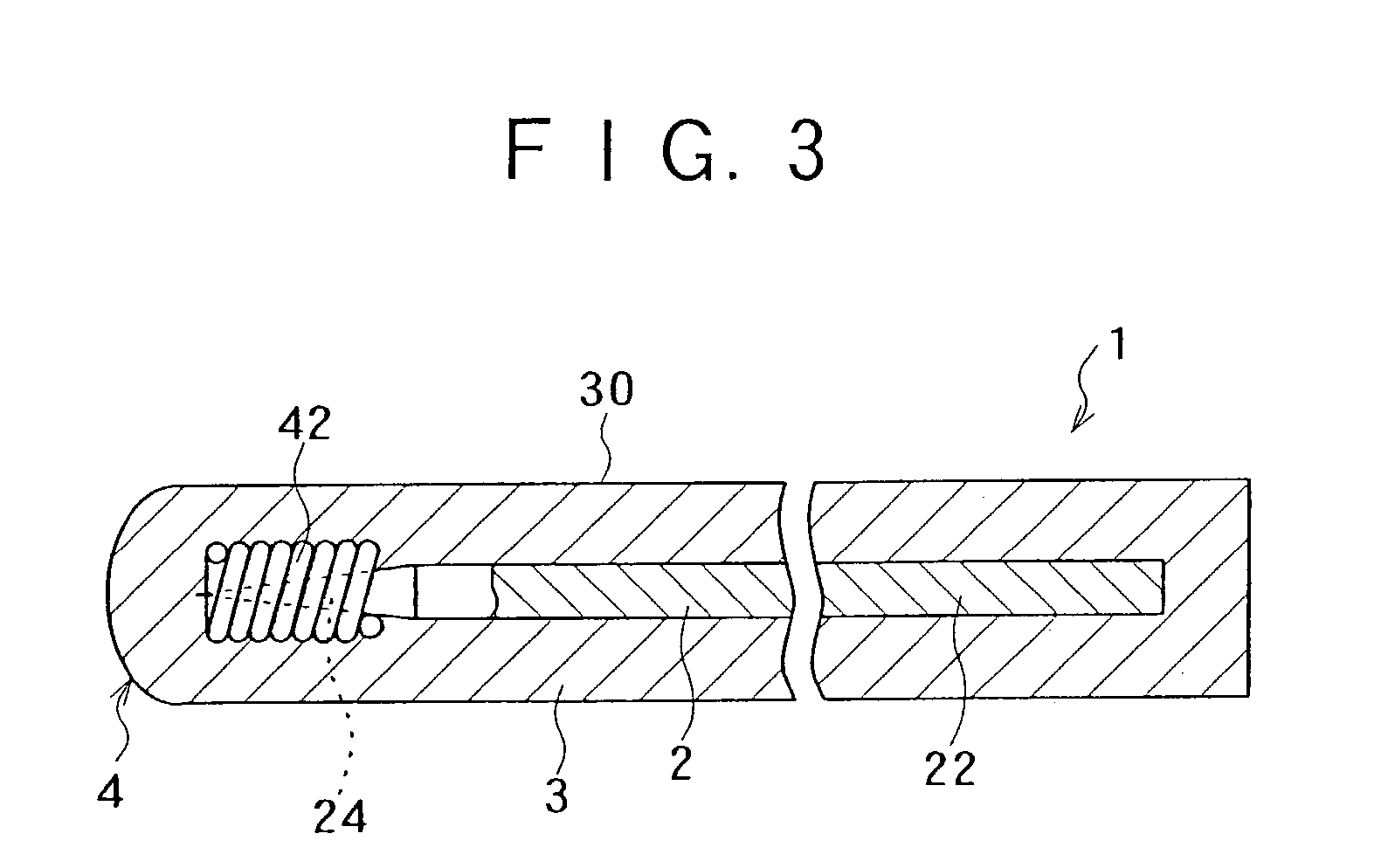Guide wire
a technology of guide wire and guiding rod, which is applied in the field of transendoscopic guide wire, can solve the problems of difficult to provide the mark at the desired position, difficulty in confirming the axial movement of the guide wire, and limitations in the degree of freedom in the shape and width of the mark, so as to improve the visibility of the color developing portion, clear color difference, and high contrastability
- Summary
- Abstract
- Description
- Claims
- Application Information
AI Technical Summary
Benefits of technology
Problems solved by technology
Method used
Image
Examples
first embodiment
[0049]FIGS. 1 and 2 illustrate a guide wire. For purposes of convenience of description, the right side and the left side in FIGS. 1 and 2 are referred to as the “proximal end side” and “distal end side” respectively.
[0050]Referring to FIG. 1, a guide wire 1 according to a first embodiment includes a linear core member 2 and a resin layer or cover layer 3. The resin layer or cover layer 3 is formed to cover at least part of the core member 2.
[0051]The core member 2 extends nearly over the entire length of the guide wire 1 and includes a main body portion 22 corresponding to a main body portion of the guide wire 1 and a taper portion 24 positioned at the distal end side of the guide wire 1. The main body portion 22 has a substantially constant diameter, while the taper portion 24 is tapered such that the outer diameter of the taper portion 24 is gradually reduced in the direction toward the distal end.
[0052]The taper portion 24 is advantageous in gradually increasing the flexibility ...
second embodiment
[0101]The contrasting portion 4 of the guide wire 1 is composed of a metal member 42 having a contrasting function. The metal member 42 surrounds at least part of a taper portion 24 of the core member 2. As shown in FIG. 3, the metal member 42 is formed to possess a coil shape, although it may be formed to possess other shapes such as a ring shape. In particular, the metal member 42 may be composed of a plurality of ring-shaped metal member parts adjacently arranged in the longitudinal direction of the core member 2.
[0102]The metal member 42 is made from, for example, tungsten or a noble metal such as gold or platinum. Among these examples of materials, tungsten is preferred.
[0103]The distal end portion of the guide wire 1 provided with the metal member 42 exhibits a good contrasting function.
[0104]According to this embodiment, because the resin layer 3 is formed to substantially cover the entire length of the core member 2 from the proximal end to the distal end of the core member...
seventh embodiment
[0156]The guide wire 1 includes a linear core member 2 having a main body portion 22 possessing a nearly constant outer diameter and a taper portion 24 provided on the distal end side from the main body portion 22. Like previous embodiments, a cover layer 3 is provided on the outer periphery of the core member 2. The cover layer 3 includes a first resin layer 31 and a second resin layer 32, with the second resin layer being positioned on the distal end side from the first resin layer 31. The second resin layer 32 is made from a material having a flexibility higher than the flexibility of the material forming the first resin layer 31.
[0157]At an overlapping portion 33 at which the distal end portion of the first resin layer 31 overlaps the proximal end portion of the second resin layer 32, the first resin layer 31 is covered by the second resin layer 32. Further, at the overlapping portion 33, the thickness of the first resin layer 31 is decreased in the direction toward the distal ...
PUM
 Login to View More
Login to View More Abstract
Description
Claims
Application Information
 Login to View More
Login to View More - R&D
- Intellectual Property
- Life Sciences
- Materials
- Tech Scout
- Unparalleled Data Quality
- Higher Quality Content
- 60% Fewer Hallucinations
Browse by: Latest US Patents, China's latest patents, Technical Efficacy Thesaurus, Application Domain, Technology Topic, Popular Technical Reports.
© 2025 PatSnap. All rights reserved.Legal|Privacy policy|Modern Slavery Act Transparency Statement|Sitemap|About US| Contact US: help@patsnap.com



